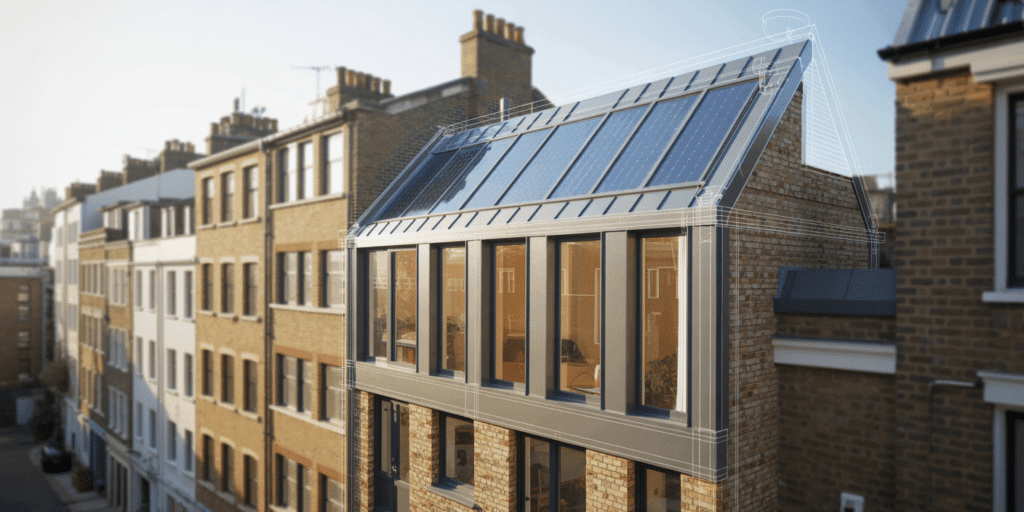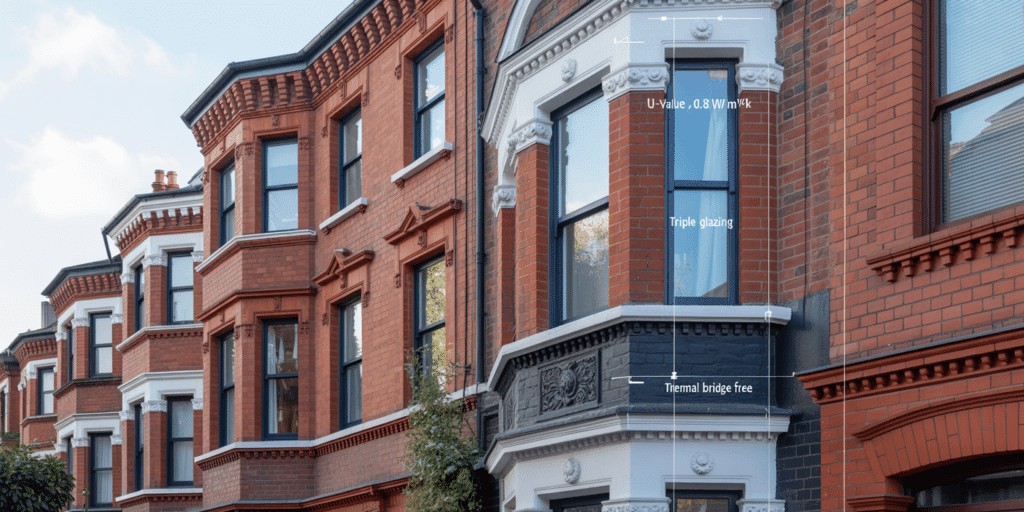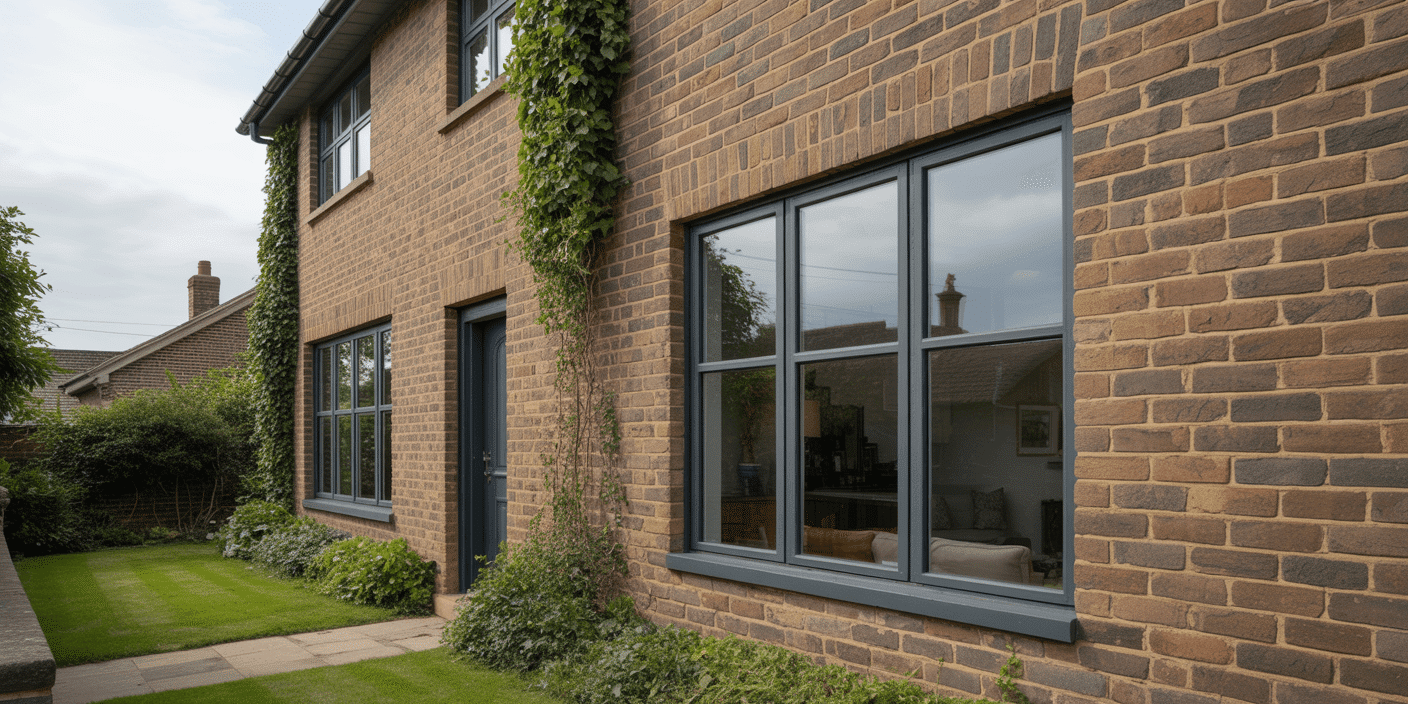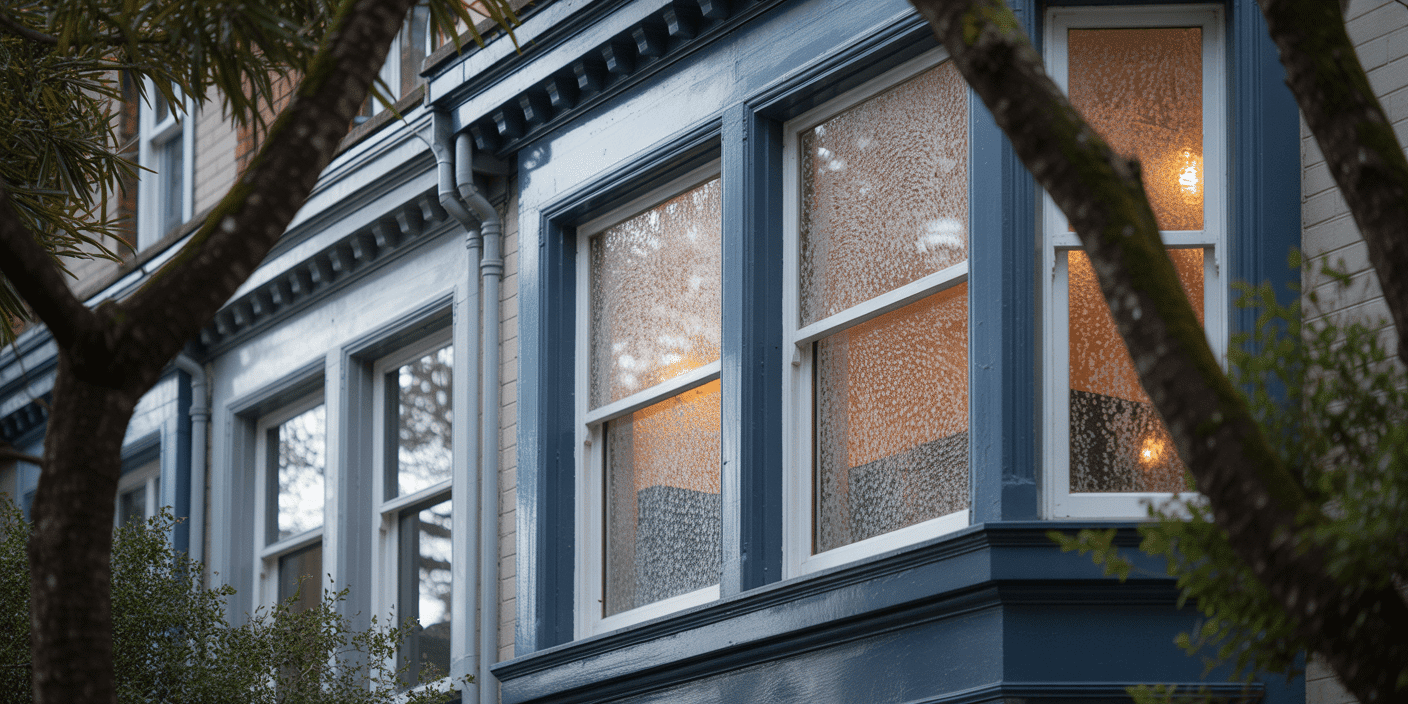You’re Heating the Street
The overlooked efficiency crisis in London’s heritage homes
Across London, some of the city’s finest properties are quietly underperforming. From elegant Georgian terraces to grand Victorian townhouses, these homes exude architectural beauty — yet behind their heritage façades, a critical flaw remains unaddressed.
Heat is escaping. Not occasionally — but continuously, and at significant cost.
Original single-glazed sash windows, while period-appropriate, are thermally obsolete. Every winter, homeowners lose an estimated £800 to £1,200 in unnecessary heating expenditure through inefficient glazing alone — not to mention the compounding effects of rising energy tariffs and evolving UK regulatory frameworks.
More than just financial waste, this energy loss translates into diminished comfort:
Persistent draughts, uneven room temperatures, and cold spots by the windows are not quirks of “old houses” — they are the result of a thermal envelope no longer fit for modern standards.
The measure of that deficiency is precise, quantifiable, and increasingly enforced:
U‑Value.
A critical metric that now defines the line between legal compliance and liability, inefficiency and long-term value, discomfort and a home that performs as beautifully as it looks.
What Is a U‑Value, Really?
The one number that defines the comfort of your home
Let’s strip away the jargon. A U‑value is simply a measure of how much heat escapes through a material. The lower the number, the better the insulation. Think of it as a “heat leak rating” — and your windows are either guarding that heat… or letting it pour out.
Here’s the scale:
| Window Type | Typical U‑Value (W/m²·K) |
| Single Glazing (old sash) | ~5.0 |
| Double Glazing (basic) | ~1.8 |
| High-Performance Triple Glazing | ~0.85 – 1.2 |
| Passivhaus Standard | ≤ 0.8 |
| UK Part L Legal Limit | ≤ 1.4 |
Now look at that again.
If your home still has original single-glazed sash windows, you’re losing up to six times more heat than necessary — every hour, every day, every winter.
But here’s the real kicker: a low U‑value doesn’t just protect your wallet. It transforms how a space feels.
- That morning chill in the front room? Gone.
- The window seat you avoid in January? Warm and inviting.
- That condensation streaking your panes? Erased.
It’s not just about efficiency — it’s about livability.
And while most window companies are still boasting about thickness or glazing count, only one is translating U‑values into real-world comfort, compliance, and character for London homes.
That’s where the real shift begins.
What Passivhaus Really Demands (And Why It Pays Off)

Performance isn’t the future — it’s already the baseline
When people hear Passivhaus, they often picture ultra-modern eco homes in the Alps — all solar panels and concrete minimalism. But that image is outdated. Today, Passivhaus is rapidly becoming the gold standard for how homes across Europe — including period properties — manage energy, comfort, and long-term cost.
At the heart of it all? Your windows.
To meet certified Passivhaus performance, windows must deliver a U‑value of 0.8 W/m²·K or better. That’s not optional — it’s essential. Why? Because windows are the most vulnerable part of your thermal envelope. No matter how thick your walls are, the wrong glazing will sabotage your entire home’s energy balance.
But Passivhaus isn’t just about one number. It’s a system:
- Exceptional airtightness: Every join, seal, and gasket matters.
- Thermal bridge elimination: No cold spots. No leaks.
- Balanced solar gain: Maximise winter sun, minimise summer overheating.
- Comfort criteria: No surface inside the home should fall below 17°C — ever.
- Ventilation synergy: Windows that work with mechanical systems, not against them.
This is more than compliance — it’s engineering for life.
And here’s the twist: you don’t need to build a new home to get there.
With the right systems, even listed London townhouses can approach Passivhaus standards — without compromising heritage, conservation, or planning constraints.
It takes precision. It takes certification.
And it takes a partner that understands both thermal logic and London’s architectural soul.
That’s exactly where Sash Windows London step into the story — fusing joinery tradition with building physics, to bring Passivhaus performance to period properties that deserve a second thermal life.
Beyond the Glass — The Whole Window System Matters
It’s not just the glazing. It’s everything around it.
Many homeowners — and even some architects — fall into the same trap: thinking that “triple glazing” alone guarantees performance.
But Passivhaus performance isn’t a glass-only equation. It’s the synergy between every single component in the window system — and most of the crucial work happens around the glazing unit.
Let’s unpack that:
- Frames
Timber, alu-clad, or composite — the frame material affects U‑value almost as much as the glass.
Poorly engineered PVC frames? They’re thermal bridges.
Thermally broken frames with low-conductivity spacers? That’s how you prevent heat transfer. - Seals & Gaskets
Airtightness isn’t a “nice to have” — it’s mandatory.
Triple-gasket systems, compression seals, and integrated weather bars eliminate draughts at the micro level.
A single millimetre gap can undo £10K worth of triple glazing. - Warm Edge Spacers
Often overlooked — but vital. These polymer spacers between panes cut down condensation and boost thermal retention, especially at night. - Low-E Coatings
These ultra-thin metallic layers reflect heat back into your home — invisible to the eye, but a powerhouse of efficiency. - Gas Fillings
Argon and krypton gas fills reduce convection between panes — acting as invisible insulation.
Now consider this:
A stunning, bespoke timber sash window with all these components aligned can outperform a basic plastic triple-glazed unit — not just in looks, but in measurable, certifiable heat retention.
That’s the difference between window selling and window engineering.
At Sash Windows London, every component is specified with forensic intent. Not just for aesthetics. Not just for tradition. But for an airtight, regulation-ready, performance-focused design that feels effortless — and looks period-correct.
What the Regulations Actually Say (Part L, Part Q, EPC)
It’s not just about comfort — it’s about compliance, resale, and your legal obligations.
Let’s be clear: thermal performance is no longer optional. The UK government has tightened building regulations, and Part L now puts glazing front and centre in energy compliance.
Part L (Conservation of Fuel and Power)
The latest revision demands that replacement windows achieve a U‑value of 1.4 W/m²·K or better. That’s across the entire window — not just the centre of the glass.
If you’re replacing or upgrading windows, this is the new legal threshold.
Fall short of it, and you may:
- Fail building control inspection
- Delay project sign-off
- Impact your EPC score negatively
Part Q (Security in Dwellings)
If you’re working on a new build or a converted dwelling, your windows must now meet specific security standards, including:
- Laminated glazing
- Multi-point locking mechanisms
- Approved hardware configurations
Your beautiful sash windows can’t just look traditional — they must lock like Fort Knox.
Part K (Protection from Falling, Collision & Impact)
If you’re glazing near floors, stairs or walkways, safety glass (usually laminated or toughened) is now required — no exceptions. This isn’t just about adults. It’s about children. About legal protection. About insurance.
EPC Ratings
Your EPC isn’t a formality anymore.
It directly affects:
- Mortgage approvals
- Resale value
- Landlord compliance
- Planning permission on future extensions or works
Poor windows can drag an otherwise efficient home down a full EPC band. In some postcodes, that could cost you £20,000–£30,000 in property value.
Here’s the point:
Your next windows aren’t just a visual upgrade. They’re a regulatory instrument — one that determines your project’s legality, its energy rating, and even its insurability.
And this is precisely where Sash Windows London separates itself.
Every unit is designed not just to look right, but to tick every regulatory box. From bespoke timber sections for conservation areas to laminated security glass and fully certified U‑value documentation, nothing is left to chance.
While others sell aesthetics, we design for compliance.
While others offer “Part L ready,” we deliver Part L locked-in — with proof.
The Cost of Not Upgrading

Ignore U‑values, and you’ll pay for it — one draught, one devaluation, one lost buyer at a time.
Let’s step beyond kilowatts and compliance for a moment. Because the real cost of inefficient windows isn’t just found on your energy bill — it’s woven through the fabric of how you live and what your home is worth.
The Energy Drain
Single-glazed sash windows can lose up to 30% of a home’s heat.
That’s £800 to £1,200 per year — gone. And in high-exposure homes or draught-prone heritage buildings, it can be even higher.
And it’s not just about the cold. It’s the invisible overwork of your heating system, the pressure on your boiler, and the silent creep of maintenance costs.
The Property Value Penalty
Buyers are savvier than ever. EPC ratings now appear on every listing. A home stuck in a D or E band can lose 5–8% in market value, simply because the windows were never upgraded.
That could mean £50,000 off the asking price in parts of London.
And more importantly, it can mean fewer viewers, longer time on the market, and reduced mortgage appeal.
The Day-to-Day Discomfort
The window seat you never sit in.
The corner of the room that stays cold.
The condensation you wipe down every morning.
The silent resignation that “old houses are just like that.”
They’re not. That discomfort is a design flaw — and it can be solved.
The Planning Risk
In certain boroughs, non-compliance with Part L or Part Q doesn’t just stall a project — it can reverse approvals, trigger enforcement, or leave you liable for costly remedial work.
So here’s the truth no one wants to say aloud:
👉 Not upgrading your windows is often more expensive than upgrading them.
👉 Not planning for performance is a hidden tax you’ll keep paying — in comfort, in value, and in peace of mind.
But there’s good news:
You don’t have to compromise heritage to gain performance.
You don’t have to gut your home to unlock 21st-century living.
With the right system — and the right partner — you can have warmth, compliance, quiet, resale value, and beauty. All in one pane.
Proof it Works: Real Homes. Real Results.
From Mayfair to Muswell Hill — the performance is no longer hypothetical.
We can talk about U‑values, Passivhaus thresholds, and Part L all day — but nothing matters more than what happens when these ideas hit the brickwork of real London homes.
Here’s what it looks like when thermal logic meets architectural soul.
Mayfair, Grade II Georgian Townhouse
Challenge: Listed building, draughty single-glazing, EPC band D.
Solution: Conservation-grade timber sash replacements, 1.1 U‑value certified, installed under tight planning parameters.
Outcome:
- EPC raised to band B
- £1,200 annual savings on heating
- No change to exterior aesthetic — approved by conservation officer
“It’s like we wrapped the house in cashmere. The cold zones are gone — and we didn’t compromise a single detail.”
— Client, W1
Camden Retrofit, Late-Victorian Terrace
Challenge: Cold spots, noisy street, condensation on glass.
Solution: Triple-glazed timber sashes with argon-fill + warm-edge spacer bars.
Outcome:
- Internal glass surface temperatures never drop below 17°C
- 40% reduction in annual heating input
- Noticeable drop in street noise
“We used to avoid the bay window in winter. Now it’s the warmest seat in the house.”
— Client, NW5
Hampstead Modern Extension
Challenge: New rear build needed to meet Passivhaus airtightness.
Solution: Alu-clad timber composite windows, U‑value 0.78, factory-sealed, thermally broken frames.
Outcome:
- Certification-ready thermal report
- Seamless blend with period joinery
- Zero cold bridging, zero thermal gaps
“Our architect said: ‘That’s the best window spec I’ve ever seen on a residential job.’”
— Client, NW3
These aren’t outliers. They’re not one-offs.
They’re the standard when you stop treating windows as a commodity — and start treating them as infrastructure.
And this is where Sash Windows London quietly sets the bar higher — not with flashy marketing, but with technical documentation, joinery precision, and thermal values that speak for themselves.
Because performance isn’t about promises.
It’s about proof.
Stop Guessing. Start Specifying.
Your windows aren’t decoration. They’re precision instruments.
At this point, it’s clear:
- U‑values matter — more than most people realise.
- Passivhaus-level performance is not just achievable in London — it’s increasingly expected.
- And window upgrades are no longer aesthetic indulgences; they’re compliance levers, energy tools, and long-term value engines.
Yet most homeowners still rely on guesswork — vague quotes, generic specs, and showroom promises that fall apart under scrutiny.
It doesn’t have to be that way.
Start with a Thermal Audit
Let us measure what your windows are really doing. Not what they should be doing.
We’ll give you the numbers. The gaps. The risk points. The opportunities.
Get a Custom Specification Plan
Every property is different — Georgian townhouse, mid-century modern, or new-build hybrid. We’ll engineer a window solution that respects your aesthetic and meets every modern standard.
Receive Full Part L, Part Q, and EPC-Ready Documentation
When Building Control shows up — or your buyer’s solicitor starts asking questions — you’ll be ready. With certified paperwork, thermal modelling, and performance proof.
No jargon. No guesswork. No regrets.
Just warm rooms. Quiet mornings. Stronger value.
And glazing systems that finally do justice to the homes they live in.
Ready to Specify Your Performance Upgrade?
→ Book a Thermal Assessment
→ Download our EPC & Part L Readiness Pack
→ Speak to a Window Specialist Today
Because once you understand U‑values, you stop accepting average.
And that’s exactly where Sash Windows London enters the frame.







